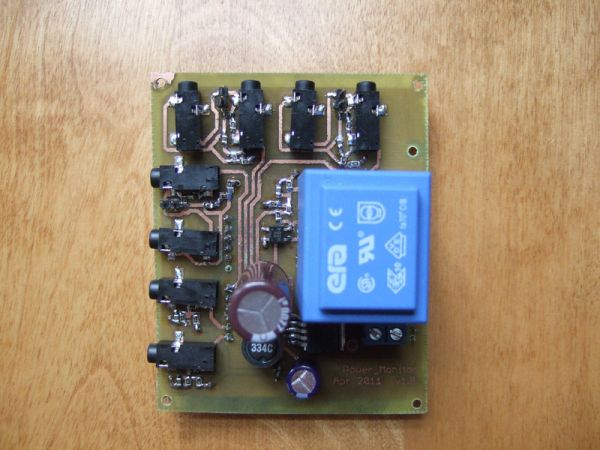Although products are becoming more and more available for monitoring your home power usage, I’m one of those idiots who can’t leave well enough alone and who would rather shell out $100 and hours of my time in order to save $20 and learn something in the process. Building on the fine work of Trystan Lea and others at OpenEnergyMonitor.org as well as various and sundry web sources and acquaintances the result is a self-contained Arduino shield for monitoring the energy usage of your home using clamp on current transformers, an ethernet shield, and an Arduino. The resulting Energy Monitoring Shield has a built in switching power supply and with mains voltage (120VAC in the US) to the board can do power factor correction as well. With mains voltage to the board it is also more dangerous than your typical home electronics project and as such has been rejected for distribution by commercial maker outlets like adafruit and sparkfun. So take that as a warning, and if in doubt, keep one hand in your pocket and out of puddles when handling the board.

In simple terms, the power monitor shield provides an AC to DC power source for the Arduino and Ethernet Shield, samples the AC voltage waveform for power factor correction, and uses the current transformers to measure current draw of branch circuits in your home breaker box.
Features:
* Connectors for easy integration with clamp on current transformers
* Built in 120VAC to 5VDC switching power supply for powering Arduino and Ethernet Shields
* Monitor up to 5 branch circuits at once, of which up to 3 can be two wire single phase 240VAC
* Power factor correction for power measurements
* Code interfaces with Pachube (now COSM) internet of things for data presentation
* Makes your breaker box a mess
DISCLAIMER: This project requires working with 120 and/or 240VAC, which can kill or seriously injure you if you are not careful. Please be aware of and follow all applicable safety practice, electrical code, and Geneva Convention guidelines.
Step 1: BOM
30A split core clamp on current transformer
100A non-invasive AC current sensor
If you need a larger current transformer for getting around the main house service wires (big thick ones) you can get bigger sensors such as:
Split-Core AC Current Sensor SCT-0750
If you go with a current transformer that does not have a 1/8″ phono end connector on it you will also need to source and attach them. You can get these from cutting off old headphones, or from Radio Shack, Ax-man for those distinguished enough to have the means, or elsewhere.
It should be noted that the values for a lot of the resistors below depend on the current sensors and measurement ranges you desire to measure. Read up on the web on current transformers for more information.
PCB BOM
Part Value Device Package
B1 HD04-RECTIFIER HD04-RECTIFIER MINIDIP-4
C1 10u C-USC0805 C0805
C2 10u C-USC0805 C0805
C3 10u C-USC0805 C0805
C4 10u C-USC0805 C0805
C5 10u C-USC0805 C0805
C6 10u C-USC0805 C0805
C7 330u CPOL-USE3.5-8 E3,5-8
C9 2200u CPOL-USE5-13 E5-13
D1 SCHOTTKY-DIODE SOD123FL
JP1 PINHD-1X2 1X02
JP2 PINHD-1X2 1X02
JP3 PINHD-1X25MM_TERMINAL 5MM_TERMINAL
JP4 PINHD-1X2 1X02
JP5 PINHD-1X2 1X02
L1 330u L-US6000-XXX-RC 6000-XXXX-RC
R1 10k R-US_M0805 M0805
R2 10k R-US_M0805 M0805
R3 10k R-US_M0805 M0805
R4 10k R-US_M0805 M0805
R5 100 R-US_M0805 M0805
R6 10k R-US_M0805 M0805
R7 10k R-US_M0805 M0805
R8 100 R-US_M0805 M0805
R9 10k R-US_M0805 M0805
R10 10k R-US_M0805 M0805
R11 100 R-US_M0805 M0805
R12 10k R-US_M0805 M0805
R13 10k R-US_M0805 M0805
R14 100 R-US_M0805 M0805
R15 10k R-US_M0805 M0805
R16 10k R-US_M0805 M0805
R17 100 R-US_M0805 M0805
R18 10k R-US_M0805 M0805
R19 10k R-US_M0805 M0805
R20 100 R-US_M0805 M0805
R21 100 R-US_M0805 M0805
R22 100 R-US_M0805 M0805
TR1 EI30-1 EI30-1
U$2 LM2575 LM2575 TO263-5
U$3 AUDIO-JACKSMT SJ-3523-SMT-JACK
U$4 AUDIO-JACKSMT SJ-3523-SMT-JACK
U$5 AUDIO-JACKSMT SJ-3523-SMT-JACK
U$6 AUDIO-JACKSMT SJ-3523-SMT-JACK
U$7 AUDIO-JACKSMT SJ-3523-SMT-JACK
U$8 AUDIO-JACKSMT SJ-3523-SMT-JACK
U$9 AUDIO-JACKSMT SJ-3523-SMT-JACK
U$10 AUDIO-JACKSMT SJ-3523-SMT-JACK
Step 2: Schematic and Board
B1 HD04-RECTIFIER HD04-RECTIFIER MINIDIP-4
C1 10u C-USC0805 C0805
C7 330u CPOL-USE3.5-8 E3,5-8
C9 2200u CPOL-USE5-13 E5-13
D1 SCHOTTKY-DIODE SOD123FL
JP1 PINHD-1X2 1X02
JP5 PINHD-1X2 1X02
L1 330u L-US6000-XXX-RC 6000-XXXX-RC
R1 10k R-US_M0805 M0805
R22 100 R-US_M0805 M0805
TR1 EI30-1 EI30-1
U$2 LM2575 LM2575 TO263-5
U$3 AUDIO-JACKSMT SJ-3523-SMT-JACK
For more detail: Arduino home energy monitor shield

